CO2emissions from global domestic aviation were reduced by 31.93% (−116.49 MtCO2) in 2020 compared to 2019 (). There were two occurrences where global aviation emissions were considerably reduced in 2020, one in Asia close to the end of January and another during the implementation of lockdown measures worldwide in mid-March. Global international aviation was greatly affected by the worldwide lockdowns, which showed a reduction in emissions of 72% in July 2020 compared to July 2019.
- climate change
- COVID-19
- CO
- fossil fuel
- Malaysia
1. Introduction
Coronavirus disease 2019 (COVID-19) is the first worldwide pandemic caused by a coronavirus. Since the first confirmed case was found in China, the novel coronavirus has evolved and spread rapidly to many countries around the world [1]. This onset of COVID-19 health pandemic in early 2020 has seen a new global recession bringing about adverse impacts on economies and labour markets. The global gross domestic product (GDP) in 2020 is expected to decline by 3.9%, whereas China’s GDP loss may hit 4.3% [2]. The COVID-19 pandemic has negatively affected many industries such as energy, manufacturing, agriculture, finance, healthcare, food, education, tourism, and sports [3]. The drastic lockdown measures implemented to curb the rapid spread of COVID-19, which included social distancing, minimum travelling, banning of gatherings, and border closures, have decreased the oil demand in many countries. These measures, coupled with the Saudi–Russia oil price war, have lowered the global greenhouse gas (GHG) emissions, but this phenomenon is only temporary [3]. In March to July 2020, strict lockdown measures were enforced by many countries around the world, but after the lockdown was lifted, the global CO 2 emissions increased quickly due to the partial startup of the economy, especially in China and some European countries [4].
The primary cause of rising global temperatures is the release of carbon dioxide (CO 2) from burning coal, oil, and natural gas [5]. There are two primary factors affecting CO 2 concentration in the atmosphere: (i) the natural carbon cycle whereby carbon is exchanged between the atmosphere and the Earth, and (ii) anthropogenic CO 2 emissions to the atmosphere via the combustion of fossil fuels [6][7]. In 2020, natural gas and coal remain the top two energy sources used for electricity generation in the Organisation for Economic Co-operation and Development (OECD) countries, having shares of 29.5% and 19.2%, respectively [8]. Given that fossil fuels are currently still the main energy source for many countries and fossil fuel power plants will continue operation until net zero in the global energy sector is achieved by 2050 [9] , it is important to fund research in raising the efficiencies and dropping CO 2 emissions of existing modern gas- and coal-fired power plants [10][11][12]. At the same time, it is also crucial to fund research in renewable energy as electricity production from renewables in the OECD increased by 7.5% (228.8 TWh) in 2020 compared to 2019. Solar, wind, and hydropower recorded significant increments of 20.2% (73.0 TWh), 11.5% (95.0 TWh), and 3.5% (52.3 TWh), generating 4.2%, 8.9%, and 15.0% of total electricity in 2020, respectively [8]. Following the COVID-19 pandemic, the global natural gas consumption and the global demand for coal to generate electricity declined by 4% and 3.3% in 2020 compared to 2019 [13][14]. A mild winter in the northern hemisphere in early 2020 and the global lockdown during the first half of 2020 negatively affected all major gas markets, except for China where growth was sluggish at best [13]. The greatest reduction in coal-fired electricity production was in the European Union (−19%, −111 TWh) and the United States of America (U.S.A.) (−14%, −196 TWh) [14]. The reduction in demand for fossil fuels due to the global lockdown, together with the increase in utilization of renewables, 2020 saw an overall decrease in CO 2 emissions of 4.02% (−1365.83 MtCO 2) [15]. According to a June 2020 report by the United Nations Environment Program (UNEP), the slowdown caused by COVID-19 pandemic in the fossil fuel industry has made investments in renewable energy more cost-effective than before. The reduction in cost for renewable energy is mainly attributed to better technologies, improved production at scale, and more experienced renewable developers [16].
In the search for alternatives to fossil fuels, the concept of bioeconomy was proposed. A bioeconomy, or biobased economy, can be described as an economy where the raw materials for manufacturing, chemicals, and energy are obtained from renewable biological sources [17]. Not only is the transition from fossil-based to biobased economy essential for stopping climate change, but also important for resolving current issues surrounding health, food security, industrial restructuring, and energy security [18][19]. So far, the driving force for the development of bioeconomy worldwide has been the societal transition towards circular and low-carbon economies, which are based on the potential of providing green biofuels. The continuous backing of low-carbon technologies should be coupled with policies to gradually phase out fossil fuels. The COVID-19 pandemic, however, revealed a much wider role that bioeconomy can have to diversify supplies for food, feed, and raw materials. Views and new knowledge on a fresh perspective for future sustainable development and operation of biobased value chains are needed. The integration of renewable energy (solar, wind, hydro, geothermal, and biomass) with CO 2 utilization and carbon recycling (C-recycling) is the way forward for the circular carbon economy. C-recycling is the construction of an artificial carbon cycle, which can be combined with the natural cycle, to enhance the rate of CO 2 sequestration and increase the selectivity of end-products that are currently produced by fossil sources [20]. Liu et al. (2020) and Sikarwar et al. (2021) published comprehensive articles detailing the impacts of global lockdown due to the COVID-19 pandemic on global CO 2 emissions and the different sectors (such as power, transportation, industry, aviation, commercial, and residential) in major countries [4][21]. Naderipour et al. compiled the impacts of COVID-19 on solar energy generation and the relation between energy consumption (1973–2019) and GHG emissions (2008–2019) in Malaysia [22]. Yusup et al. analysed and compared the monthly differences in atmospheric CO 2 concentration for the world and Malaysia from 2018–2020 (from November to May of each year) [23]. To the best of our knowledge, no journal article has described the effects of COVID-19-related lockdown on daily CO 2 emissions in Malaysia.
Therefore, in this review, we discuss how worldwide lockdown due to the COVID-19 pandemic significantly reduced global CO 2 emissions. We also discuss the impacts of national lockdown in Malaysia on its daily CO 2 emissions in 2020 together with the influence of climate change on various sectors in Malaysia.
2. Overview of Greenhouse Gases
In 1896, Svante Arrhenius (1859–1927), a Swedish scientist, was the first to relate the effect of atmospheric CO 2 levels on Earth’s temperature. He observed that the infrared absorption ability of water vapour and CO 2 had kept Earth’s mean surface temperature at a comfortable 15 °C. This phenomenon is known as the natural greenhouse effect. Arrhenius calculated that a two-fold increase in CO 2 level would increase temperature by 5 °C [24]. Around the same time, Thomas Chamberlin (1843–1928), an American geologist, suggested that large alterations on Earth’s climate could be caused by variations in CO 2 levels. Both Arrhenius and Chamberlin concluded that the combustion of fossil fuels released CO 2 to the atmosphere, thereby warming the Earth [24].
Naturally, CO 2 is also generated in the atmosphere in the natural carbon cycle, but the carbon cycle maintains the balance of carbon in the atmosphere, on land, and in the ocean. In other words, the concentration of carbon in the atmosphere, land, plants, and oceans are kept relatively constant. Despite this, the carbon cycle has been altered following changes in climate. Shifts in Earth’s orbit occur continuously and in predictable cycles, varying the amount of energy Earth acquires from the Sun. This results in a cycle of warm periods and ice ages on Earth. When summers in the Northern Hemisphere become colder, ice accumulates on land and the carbon cycle slows. At the same time, several factors such as lower temperature and higher phytoplankton growth rate likely enhance the absorption of atmospheric carbon into the ocean. The reduction in atmospheric carbon further cools the Earth. Likewise, when the last Ice Age ended about 10,000 years ago, CO 2 concentrations in the atmosphere climbed rapidly as Earth’s temperatures rose [25][26][27].
Detailed analyses have been performed on air trapped in ice cores taken from Antarctica, and results have shown that for the past 800,000 years, CO 2 levels in the atmosphere had only fluctuated between 170 and 210 ppm [28]. Presently, the CO 2 level in the atmosphere is approaching 414 ppm, double that of the past 800,000 years. This rise in atmospheric CO 2 levels is due to the combustion of fossil fuels. The carbon released from combusting fossil fuels contains a different ratio of heavy-to-light carbon atoms. This produces a distinct “fingerprint” that can be quantified as (i) burning fossil fuel causes a relative decrease in the concentration of heavy carbon-13 atoms ( 13C) in the atmosphere, and (ii) burning fossil fuels reduces the ratio of oxygen to nitrogen in the atmosphere [29]. There are three different isotopes for carbon, which are carbon-12 ( 12C), carbon-13 ( 13C), and carbon-14 ( 14C). The most common is 12C, while 13C makes up around 1% of the total and 14C only accounts for around one in one trillion carbon atoms. Plants and fossil fuels (ultimately derived from ancient plants) all contain a similar 13C/ 12C ratio. The 13C/ 12C ratio in the atmosphere is 2% higher than in plants (and hence fossil fuels). When the carbon from fossil fuels is liberated into the atmosphere, the average atmospheric 13C/ 12C ratio decreases [29].
One way to reduce CO 2 emissions is the substitution of fossil fuels with biomass-derived biofuels. Although utilizing biomass-derived biofuels also emit CO 2, the benefit of biomass-derived biofuels is that the combustion of biofuels discharges carbon which is part of the natural carbon cycle. In contrast, the combustion of fossil fuels discharges carbon which was previously kept in the ground for millions of years, adding more carbon into Earth’s biosphere [30]. The additional carbon from burning fossil fuels is primarily responsible for global warming. To mitigate this, it is imperative that the global energy industry switches to biofuels and renewable energies, and reduces the dependence on fossil fuels. To this end, the implementation of renewable energy has been growing globally. For instance, the global electricity production from renewables was 27% in 2019 and 29% in 2020. In the midst of the COVID-19 pandemic in 2020, renewable energy usage increased by 3% while demand for fossil fuels dropped [31].
3. Global CO2 Emissions during COVID-19 Pandemic
When compared to 2019, there was a significant reduction in global CO 2 emissions in 2020 due to the COVID-19 pandemic. From Figure 1 [15], the total global CO 2 emissions in 2020 showed a decline of 4.02% (−1365.83 MtCO 2), with the greatest decrease in emissions occurring in the U.S.A. (−477.37 MtCO 2, −9.44%), followed by EU27–UK (−230.58 MtCO 2, −7.48%), and India (−198.44 MtCO 2, −8.07%). Lesser decrease in emissions were observed in Japan (−54.92 MtCO 2, −5.04%), Russia (−45.16 MtCO 2, −2.92%), and Brazil (−41.95 MtCO 2, −9.80%). When compared to the first half of 2019 (January to June 2019), the first half of 2020 observed a decline in global CO 2 emissions by roughly 8.8% (−1551 MtCO 2). The period when emissions declined coincided with the global spread of COVID-19 and implementation of lockdown measures in many countries worldwide between March and July 2020, with the greatest decline recorded in April 2020. The absolute reduction in CO 2 emissions over the first half of 2020 was the greatest reduction in history, surpassing the drop in emissions during the Great Recession in 2008–2009 and the end of World War II (annual decrease of 790 Mt CO 2). However, since July 2020, the global CO 2 emissions started to increase due to the relaxation of lockdown measures and partial restart of the economy, particularly in China and some European countries [4].
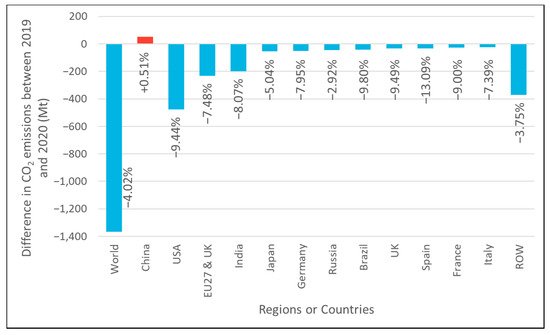
As shown in Figure 1 , China recorded overall a slight increase in total emissions in 2020 compared to 2019 (+52.96 MtCO 2, +0.51%). At the start of 2020, there was a sharp decline in China’s emissions due to the outbreak of COVID-19 and stringent lockdown measures, but these restrictions were gradually lifted starting in March. After this, CO 2 emissions in China quickly recovered in April and May. When compared to 2019, China in 2020 experienced a reduction in emissions of −18.4% in February and −9.2% in March, followed by an increase of 0.6% in April and 5.4% in May [4].
On average, 29% of the worldwide annual CO 2 emissions are released from industries such as steel, chemicals, fossil-fuel-derived goods, and cement production. Developing countries, such as China and India, typically have a greater share in these emissions [32]. However, due to the COVID-19 pandemic, the worldwide industrial emissions in 2020 declined by 1.44% (−145.05 MtCO 2) ( Figure 2 ). This included significant reductions in India (−98.63 MtCO 2, −13.13%), U.S.A. (−56.40 MtCO 2, −5.47%), and EU27–UK (−51.82 MtCO 2, −8.19%). In China’s case, its industrial emissions recorded a small increase of 2.93% (+120.36 MtCO 2) in 2020 compared to 2019. This increase can be attributed to two of China’s major industries, steel and cement, which accounted for roughly 42% and 22% of China’s industrial emissions from fuel consumption in the past several years. Despite the lockdown measures, China’s steel industry recorded a 2.2% increase in emissions in the first half of 2020 compared to 2019. For China’s cement industry, a significant decline in emissions was observed in the first three months of 2020 (−29.5% in January and February combined, and −18.3% in March). After the lockdown was relaxed in March, however, cement emissions surged to +3.8%, +8.6%, and +8.4% in April, May, and June compared to 2019 [4][33].
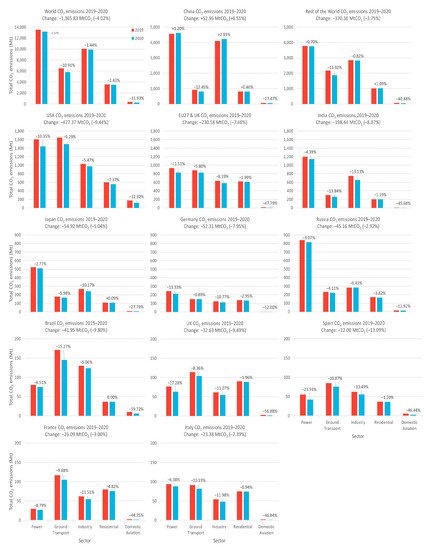
Figure 3 shows the comparison of CO 2 emissions for the world and major contributing countries or regions in the first five months of 2019, 2020, and 2021 [15][34]. Data from the first five months sufficiently covers the lockdown periods for the major countries and regions [4]. From Figure 3 , global CO 2 emissions recovered back to 2019 levels in 2021 despite a sharp decrease of 8.19% (−1160.03 MtCO 2) in 2020. After experiencing CO 2 reductions in 2020, emissions in 2021 quickly rose back to 2019 levels for EU27–UK, India, and Russia. In the case of China, its CO 2 emissions rose 9.4% above 2019 levels, observed the highest recovery of 15.44% (+610.06 MtCO 2) in 2021 compared to 2020. In contrast, emissions from U.S.A., Japan, and rest of the world (ROW) in 2021 were 7.5%, 4.1%, and 5.4% lower than their 2019 levels, despite all three registering positive emissions growth in 2021 compared to 2020. Even though there is a net reduction in emissions in 2020, the mean atmospheric CO 2 level still increased by 0.6% in 2020 (412 ppm) compared to 2019 (410 ppm). This annual rate of increase is similar to 2019, which also showed a 0.6% increase compared to 2018 (408 ppm) [35]. After global emissions in 2021 returned to 2019 levels, the mean atmospheric CO 2 level for May 2021 reached 419 ppm as measured by National Oceanic and Atmospheric Administration’s (NOAA) Mauna Loa Observatory [36]. These data showed that the CO 2 emissions savings from drastic lockdown measures on a global scale was only temporary and showed no significant effect on the annual growth of CO 2 levels [3]. This agrees with historical observations where brief decline in carbon emissions did not lead to significant climate change. To achieve long-term impacts, a systemic shift is required. Even if the lower GHG emissions due to COVID-19 were to become normal, we must still cut emissions by 50% by 2030 to prevent global mean temperature from rising more than 1.5 °C compared to pre-industrial level. This will allow us to mitigate some of the worst effects of climate change [37]. This has been the goal of the international Paris Agreement on climate change, which aims to control the rise of the global surface mean air temperature well below 2 °C compared to pre-industrial levels [38].
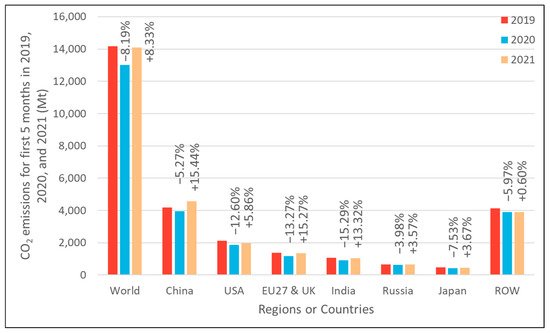
4. CO2 Emissions in Malaysia during COVID-19 Pandemic
Figure 4 [39] shows a decline in Malaysia’s CO 2 emissions during 2020 in six different areas, namely the power sector, industrial sector, ground transportation, public and residential sectors, and domestic aviation. The values in Figure 4 represent the estimated difference between daily CO 2 emissions in 2020 compared to the mean 2019 levels. From Figure 4 , total CO 2 emissions showed the highest reduction (−0.202 MtCO 2/d) in the middle of March 2020, which coincided with the implementation of lockdown measures by the government, known as Movement Control Order (MCO), to curb the rapid spread of COVID-19. The spike in positive cases from 29 cases on 1 March to 553 cases on 16 March, due to mass gathering at a religious event, prompted the government to enforce first phase MCO from 18 March to 31 March [40][41]. The MCO enforced rules such as banning of movement and assembly, banning of overseas and interstate travel, closure of all educational institutions, closure of all nonessential public and private premises, social distancing, and allowing only one person per household to leave home for purchasing essential items [42][43]. The government then implemented three more phases of MCO, extending the lockdown period from April to early May. These restrictions were reflected by significant reductions in CO 2 emissions in power generation (−0.052 MtCO 2/d, 26% share of total reductions during MCO), industrial sector (−0.047 MtCO 2/d, 23% share), and ground transportation (−0.093 MtCO 2/d, 46% share) from March to May as all nonessential sectors were closed ( Figure 4 ). The public sector and aviation industry saw a lesser decrease in emissions of −0.006 MtCO 2/d (28% share) and −0.005 MtCO 2/d (23% share), respectively. In the same period, CO 2 emissions from the residential sector saw a slight increase of 0.0005 MtCO 2/d as all residents stayed at home. Outside of MCO, residential emissions stayed the same as their mean 2019 levels.
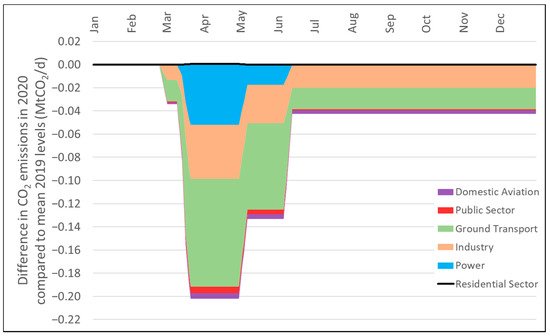
The government gradually relaxed the lockdown measures by establishing Conditional Movement Control Order (CMCO) in two phases from 4 May to 9 June. Under the CMCO, several sectors of the economy were permitted to resume provided that all employers and employees complied to the Standard Operating Procedures (SOPs) specified by the government [44][45]. The partial restart of the economy increased the daily CO 2 emissions during CMCO to −0.133 MtCO 2 /d (34% recovery) compared to the MCO period ( Figure 4 ). Emissions from power generation recorded the highest recovery of 67% (−0.017 MtCO 2/d) compared to the MCO period. This was followed by industrial and ground transportation emissions, registering recoveries of 29% (−0.033 MtCO 2/d) and 20% ( −0.075 MtCO 2/d).
As the rate of infection was largely under control due to the MCO and CMCO measures, the government introduced Recovery Movement Control Order (RMCO) after CMCO ended. The first two phases of RMCO lasted from 10 June to 31 December 2020 [46][47], while the third phase continued from 1 January to 31 March 2021 [48]. Under RMCO, restrictions were further relaxed while still adhering to the SOPs. RMCO allowed interstate travel (but not international travel), normal business operations, small-scale gatherings for recreation and sports (except sporting events and contact sports), gradual reopening of schools, and small congregations of worshippers at mosques and suraus [46]. The RMCO initiated another increase in daily CO 2 emissions to −0.043 MtCO 2/d (79% recovery compared to the MCO period), which stabilized until the end of 2020 ( Figure 4 ). Upon the start of RMCO, CO 2 emissions from power generation completely recovered to 2019 levels. Compared to the MCO period, emissions from ground transportation and public sector showed high recoveries of 80% (−0.019 MtCO 2/d) and 78% ( −0.0009 MtCO 2/d), respectively. Meanwhile, industrial and aviation emissions showed lower recoveries of 57% (−0.020 MtCO 2/d) and 34% (−0.003 MtCO 2/d). By the end of 2020, Malaysia’s total CO 2 emissions were 225.97 MtCO 2, a notable decline of 9.7% from 250.09 MtCO 2 in 2019 ( Figure 5 ) [39].
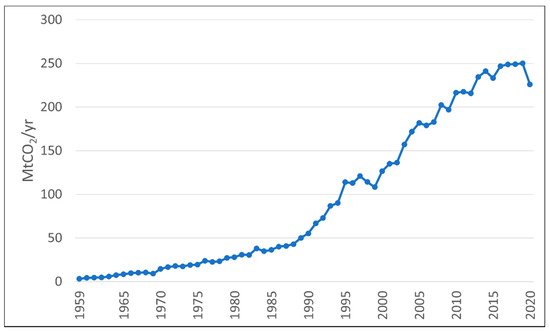
This entry is adapted from the peer-reviewed paper 10.3390/su13158461
References
- Liu, Y.-C.; Kuo, R.-L.; Shih, S.-R. COVID-19: The first documented coronavirus pandemic in history. Biomed. J. 2020, 43, 328–333.
- Maliszewska, M.; Mattoo, A.; Van der Mensbrugghe, D. The Potential Impact of COVID-19 on GDP and Trade: A Preliminary Assessment; The World Bank: Washington, DC, USA, 2020.
- Nicola, M.; Alsafi, Z.; Sohrabi, C.; Kerwan, A.; Al-Jabir, A.; Iosifidis, C.; Agha, M.; Agha, R. The socio-economic implications of the coronavirus and COVID-19 pandemic: A review. Int. J. Surg. 2020, 78, 185–193.
- Liu, Z.; Ciais, P.; Deng, Z.; Lei, R.; Davis, S.J.; Feng, S.; Zheng, B.; Cui, D.; Dou, X.; Zhu, B. Near-real-time monitoring of global CO2 emissions reveals the effects of the COVID-19 pandemic. Nat. Commun. 2020, 11, 5172.
- Dehghani-Sanij, A.; Bahadori, M.N. Energy consumption and environmental consequences. In Ice-Houses: Energy, Architecture, and Sustainability; Dehghani-Sanij, A., Bahadori, M.N., Eds.; Academic Press: Cambridge, MA, USA, 2021; pp. 1–55.
- Jackson, R.B.; Le Quéré, C.; Andrew, R.; Canadell, J.G.; Korsbakken, J.I.; Liu, Z.; Peters, G.P.; Zheng, B. Global energy growth is outpacing decarbonization. Environ. Res. Lett. 2018, 13, 120401.
- Peters, G.P.; Andrew, R.M.; Canadell, J.G.; Friedlingstein, P.; Jackson, R.B.; Korsbakken, J.I.; Le Quéré, C.; Peregon, A. Carbon dioxide emissions continue to grow amidst slowly emerging climate policies. Nat. Clim. Chang. 2020, 10, 3–6.
- International Energy Agency (IEA). Key Electricity Trends 2020: Annnual Trends from OECD Countries. Available online: https://www.iea.org/articles/key-electricity-trends-2020 (accessed on 21 July 2021).
- International Energy Agency (IEA). Net Zero by 2050: A Roadmap for the Global Energy Sector; IEA: Paris, France, 2021.
- Khallaghi, N.; Hanak, D.P.; Manovic, V. Techno-economic evaluation of near-zero CO2 emission gas-fired power generation technologies: A review. J. Nat. Gas. Sci. Eng. 2020, 74, 103095.
- Tumanovskii, A.G.; Shvarts, A.L.; Somova, E.V.; Verbovetskii, E.K.; Avrutskii, G.D.; Ermakova, S.V.; Kalugin, R.N.; Lazarev, M.V. Review of the coal-fired, over-supercritical and ultra-supercritical steam power plants. Therm. Eng. 2017, 64, 83–96.
- Hoseinzadeh, S.; Stephan Heyns, P. Advanced energy, exergy, and environmental (3E) analyses and optimization of a coal-fired 400 MW thermal power plant. J. Energy Resour Technol. 2021, 143, 082106.
- International Energy Agency (IEA). Gas 2020: Analysing the Impact of the COVID-19 Pandemic on Global Natural Gas Markets; IEA: Paris, France, 2020.
- International Energy Agency (IEA). Coal 2020: Analysis and Forecast to 2025; IEA: Paris, France, 2020.
- Carbon Monitor. CO2 Emissions Variation (%): January 1st to December 31st, 2020 vs. January 1st to December 31st, 2019. Available online: https://carbonmonitor.org/ (accessed on 12 April 2021).
- Frankfurt School-UNEP Centre/BNEF. Global Trends in Renewable Energy Investment 2020; FS-UNEP Centre: Frankfurt, Germany, 2020.
- McCormick, K.; Kautto, N. The Bioeconomy in Europe: An Overview. Sustainability 2013, 5, 2589–2608.
- Ollikainen, M. Forestry in bioeconomy—Smart green growth for the humankind. Scand. J. For. Res. 2014, 29, 360–366.
- Pülzl, H.; Kleinschmit, D.; Arts, B. Bioeconomy—An emerging meta-discourse affecting forest discourses? Scand. J. For. Res. 2014, 29, 386–393.
- Aresta, M.; Dibenedetto, A. Carbon Recycling Through CO2-Conversion for Stepping Toward a Cyclic-C Economy. A Perspective. Front. Energy Res. 2020, 8, 159.
- Sikarwar, V.S.; Reichert, A.; Jeremias, M.; Manovic, V. COVID-19 pandemic and global carbon dioxide emissions: A first assessment. Sci. Total Environ. 2021, 794, 148770.
- Naderipour, A.; Abdul-Malek, Z.; Ahmad, N.A.; Kamyab, H.; Ashokkumar, V.; Ngamcharussrivichai, C.; Chelliapan, S. Effect of COVID-19 virus on reducing GHG emission and increasing energy generated by renewable energy sources: A brief study in Malaysian context. Environ. Technol. Innov. 2020, 20, 101151.
- Yusup, Y.; Kayode, J.S.; Ahmad, M.I.; Yin, C.S.; Hisham, M.S.M.N.; Isa, H.M. Atmospheric CO2 and total electricity production before and during the nation-wide restriction of activities as a consequence of the COVID-19 pandemic. arXiv 2020, arXiv:2006.04407.
- Maslin, M. Global Warming: A Very Short Introduction, 2nd ed.; Oxford University Press: Oxford, UK, 2008.
- Lüthi, D.; Le Floch, M.; Bereiter, B.; Blunier, T.; Barnola, J.-M.; Siegenthaler, U.; Raynaud, D.; Jouzel, J.; Fischer, H.; Kawamura, K. High-resolution carbon dioxide concentration record 650,000–800,000 years before present. Nature 2008, 453, 379–382.
- Jouzel, J.; Masson-Delmotte, V.; Cattani, O.; Dreyfus, G.; Falourd, S.; Hoffmann, G.; Minster, B.; Nouet, J.; Barnola, J.-M.; Chappellaz, J. Orbital and millennial Antarctic climate variability over the past 800,000 years. Science 2007, 317, 793–796.
- NASA—Earth Observatory. Changes in the Carbon Cycle. Available online: https://earthobservatory.nasa.gov/features/CarbonCycle/page4.php (accessed on 9 May 2021).
- Joos, F.; Spahni, R. Rates of change in natural and anthropogenic radiative forcing over the past 20,000 years. Proc. Natl. Acad. Sci. USA 2008, 105, 1425–1430.
- NASA—Global Climate Change. The Atmosphere: Getting a Handle on Carbon Dioxide. Available online: https://climate.nasa.gov/news/2915/the-atmosphere-getting-a-handle-on-carbon-dioxide/ (accessed on 15 October 2020).
- IEA Bioenergy. Is Energy from Woody Biomass Positive for the Climate? IEA Bioenergy: Paris, France, 2018.
- International Energy Agency (IEA). Global Energy Reviews 2021: Renewables; IEA: Paris, France, 2021.
- Oliver, J.; Peters, J. Trends in Global CO2 and Total Greenhouse Gas Emissions: 2019 Report; PBL Netherlands Environmental Assessment Agency: The Hague, The Netherlands, 2019.
- Liu, Z.; Ciais, P.; Deng, Z.; Davis, S.J.; Zheng, B.; Wang, Y.; Cui, D.; Zhu, B.; Dou, X.; Ke, P. Carbon Monitor, a near-real-time daily dataset of global CO2 emission from fossil fuel and cement production. Sci. Data 2020, 7, 392.
- Carbon Monitor. CO2 Emissions Variation (%): January 1st to May 31st, 2021 vs. January 1st to May 31st, 2020. Available online: https://carbonmonitor.org/ (accessed on 8 July 2021).
- Dlugokencky, E.; Tans, P. Trends in Atmospheric Carbon Dioxide. Available online: https://www.esrl.noaa.gov/gmd/ccgg/trends/global.html (accessed on 9 May 2021).
- NOAA. Carbon Dioxide Peaks Near 420 Parts per Million at Mauna Loa Observatory. Available online: https://research.noaa.gov/article/ArtMID/587/ArticleID/2764/Coronavirus-response-barely-slows-rising-carbon-dioxide (accessed on 8 July 2021).
- Forster, P.M.; Forster, H.I.; Evans, M.J.; Gidden, M.J.; Jones, C.D.; Keller, C.A.; Lamboll, R.D.; Le Quéré, C.; Rogelj, J.; Rosen, D. Current and future global climate impacts resulting from COVID-19. Nat. Clim. Chang. 2020, 10, 913–919.
- Jackson, R.; Friedlingstein, P.; Andrew, R.; Canadell, J.; Le Quéré, C.; Peters, G. Persistent fossil fuel growth threatens the Paris Agreement and planetary health. Environ. Res. Lett. 2019, 14, 121001.
- Le Quéré, C.; Jackson, R.B.; Jones, M.W.; Smith, A.J.; Abernethy, S.; Andrew, R.M.; De-Gol, A.J.; Shan, Y.; Canadell, J.G.; Friedlingstein, P.; et al. Temporary reduction in daily global CO2 emissions during the COVID-19 forced confinement (Version 1.3). Glob. Carbon Project 2020.
- DG of Health Malaysia. Press Statement 1 Mar 2020—Updates on the Coronavirus Disease 2019 (COVID-19): Situation in Malaysia. Available online: https://kpkesihatan.com/2020/03/01/kenyataan-akhbar-kpk-1-mac-2020-situasi-semasa-jangkitan-penyakit-coronavirus-2019-COVID-19-di-malaysia/ (accessed on 8 July 2021).
- DG of Health Malaysia. Press Statement 16 Mar 2020—Updates on the Coronavirus Disease 2019 (COVID-19): Situation in Malaysia. Available online: https://kpkesihatan.com/2020/03/16/kenyataan-akhbar-ybmk-16-mac-2020-situasi-semasa-jangkitan-penyakit-coronavirus-2019-COVID-19-di-malaysia/ (accessed on 8 July 2021).
- Prime Minister’s Office of Malaysia. The Prime Minister’s Special Message on COVID-19—16 March 2020. Available online: https://www.pmo.gov.my/2020/03/perutusan-khas-yab-perdana-menteri-mengenai-COVID-19-16-mac-2020/ (accessed on 8 July 2021).
- Tang, K.H.D. Movement control as an effective measure against COVID-19 spread in Malaysia: An overview. J. Public Health 2020, 1–4.
- DG of Health Malaysia. Press Statement 4 May 2020—Updates on the Coronavirus Disease 2019 (COVID-19): Situation in Malaysia. Available online: https://kpkesihatan.com/2020/05/04/kenyataan-akhbar-kpk-4-mei-2020-situasi-semasa-jangkitan-penyakit-coronavirus-2019-COVID-19-di-malaysia/ (accessed on 8 July 2021).
- The Star. PM: CMCO Extended Till June 9. Available online: https://www.thestar.com.my/news/nation/2020/05/11/pm-cmco-extended-till-june-9 (accessed on 8 July 2021).
- New Straits Times. CMCO to End, Replaced with RMCO Until Aug 31. Available online: https://www.nst.com.my/news/nation/2020/06/598700/cmco-end%C2%A0replaced-rmco-until-aug-31 (accessed on 8 July 2021).
- New Straits Times. RMCO Extended Until Dec 31, Says PM Muhyiddin. Available online: https://www.nst.com.my/news/nation/2020/08/620307/rmco-extended-until-dec-31-says-pm-muhyiddin (accessed on 8 July 2021).
- The Sun Daily. RMCO Extended Till March 31 (Updated). Available online: https://www.thesundaily.my/home/rmco-extended-till-march-31-updated-DJ5902252 (accessed on 8 July 2021).
